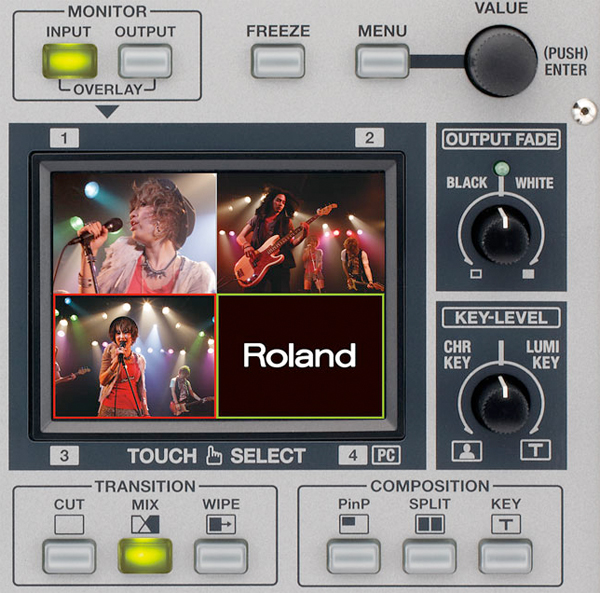Review: Roland VR-3 All-In-One A/V Mixer—UPDATED!
If you're in the market for an all-in-one video mixer for webcasting 4:3 NTSC video, Roland's compact new VR-3 fits the bill nicely. If you need widescreen video output, you may need to add some steps to your workflow when you pair NTSC widescreen video with many of the popular streaming services.
Video Features
On the video side, the VR-3 has a built-in touch-screen LCD monitor that displays each of the 4 SD RCA inputs. If you want a larger image than the multi-view LCD provides, there is a multi-view preview RCA output that allows you to connect the VR-3 to a larger monitor. The VR-3 also has a pair of program outputs in case you two video feeds.
Additional features include a freeze button, which holds the live input feed, and is great if you ever need to switch the computer connected to the single VGA input, which when live, replaces the fourth RCA input. Having a VGA input scan converter is the easiest way to get a computer feed into the video mixer so having this functionality built-in means one less piece of equipment. The VR-3 also has a nice output fade knob that lets you fade to black or even white at the end of your programming.

Monitoring inputs on the VR-3’s multi-view LCD with freeze and fade controls
You can use either the touchscreen or buttons to switch inputs, but there is no T-bar on the VR-3, so transition time has to be set in the menu. There is even an audio delay setting for both the USB and analog outputs to account for differences in the speed of video and audio processing and so that your lips are always synced.
SD and 4:3
Overall the VR-3 is a very compact and capable a/v mixer but if you are interested in one there are a few things you should consider. This is a standard definition (SD) video mixer and thus, as a 2012 release, has limited applications in a video world where HD is already being supplanted in some circles with 3D and 4K video. The manual reveals that the USB video output is 720x480 Motion JPEG, but what it doesn’t mention is that the video output is designed around an NTSC 4:3 non-square pixel output with a 0.9 pixel aspect ratio.
This is what Roland’s website says about web streaming:
As a USB Video/Audio class device, web streaming is effortless by simply connecting to a computer running a live streaming service such as USTREAM , Livestream, Stickam, Justin.tv, worshipstream.com, websharelive.com, etc.
While the USB output makes it much easier to stream video without a capture card, when it comes to widescreen video, which has been the standard for several years, I wouldn’t consider the process effortless.
Related Articles
This capture software was developed to meet the request from Windows users who want to record/capture the audio and video during live events using any of the products from the Roland VR or VC line-up
New switcher designed for live events and installations, augments V-1600HD and V-800HD lineup with 12 inputs on 4 channels plus 1 (background), and 2 output buses with independent scalers on the inputs and outputs allowing you to connect HDMI/DVI, RGB, component, and composite sources
Video production and encoding expert Jan Ozer describes the workflow and challenges of a Livestream webcast he produced for marimba player Larissa Venzie using the Roland VR-3 and Next Computer's Radius portable workstation.